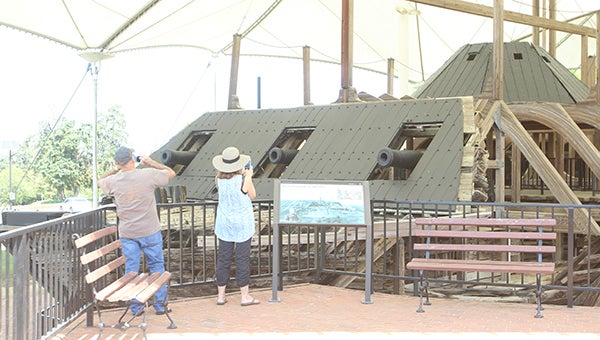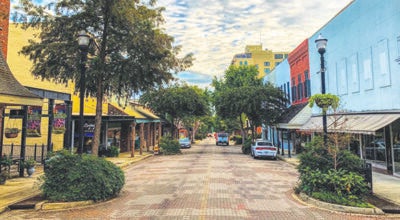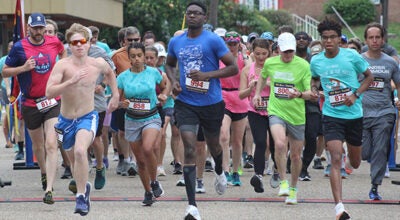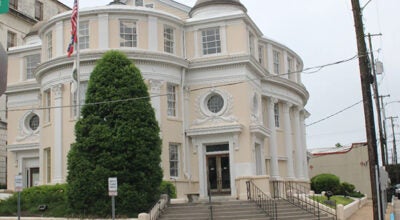Cairo, one of a kind exhibit, offers a glimpse of life on an ironclad
Published 10:11 am Tuesday, April 19, 2016

- Visitors to the Cairo and its museum try to capture a photo of the boat with their smart phones.
Nestled among the many monuments and memorials to Union and Confederate generals, units and troops at the Vicksburg National Military Park is a one-of-a-kind exhibit.
“There are three sites people should see when they visit the park,” said park ranger David Slay, site supervisor for the ironclad gunship USS Cairo and its museum, “The Illinois Monument, Fort Hill and the Cairo.”
The Cairo is the nation’s only restored Civil War ironclad; a structure of white oak, covered on one side with its original armored plating and displaying the 13 guns it carried into battle the night it sank in the Yazoo River. Its adjacent museum has artifacts recovered from the boat.
The boat and the museum are at the base of Union Avenue and across from the National Cemetery.
And when visitors come down Union Avenue where the steep slope bends they get a shock.
“The Cairo really surprises people when they come down that hill,” Slay said. “They’re not expecting to see something that big. Their expression is shock and awe. It’s like seeing the Grand Canyon for the first time. You’re amazed at how big it is. You just see the boat.
“This is the most intact Civil War vessel on display. There are some replicas, but no one has the whole boat like we do.”
Inside the museum, the artifacts from the Cairo give visitors a glimpse of life aboard an ironclad vessel. That includes cannon balls and shells from rifled guns recovered from the boat.
Many of the items on display, said Elizabeth Joyner, a former Cairo site supervisor, said, have familiar names.
“The sailor’s combs were made by Goodyear Rubber Co.,” she said. “Some of the medicine bottles were made by Squib and some have the original liquids inside. There is even a bottle for Lee & Perrin’s Worcestershire sauce.”
The difference between the sailors and officers is shown by the eating utensils, with the sailors eating from tin plates and the officers using china and silverware. There’s black boot polish that is still useable.
“Serving in the 19th century navy was brutal,” Slay said. “In the summer, the temperature in an ironclad would reach 125 degrees, and the men slept in hammocks on the gun deck. There weren’t that many experienced sailors, so most of the people on board were landsmen.
“About 25 percent of the men in the Navy on the Mississippi were black men who were either freedmen or slaves who had run away.”
The Cairo was one of seven ironclads called the “City Class,” because they were named after cities on the Ohio and Mississippi Rivers. It was part of the Union’s Mississippi River Squadron, the first “brown water navy” and part of a Union plan to cut off supplies by blockading and capturing Confederate ports.
And the story of how the Cairo came into the park’s possession goes back to Dec. 12, 1862, when the boat was part of a flotilla assigned to remove torpedoes (mines) from the Yazoo River in preparation for an assault on Vicksburg from the north by Gen. William Tecumseh Sherman.
Sharpshooters were on boats shooting out the fuses on the mines when they came under fire from Confederate snipers. According to the story, the Cairo’s captain, Lt. Cmdr. Thomas O. Selfridge Jr. believed he was under attack and began moving the Cairo forward when the boat struck two mines and went down in 36 feet of water in 12 minutes. All hands evacuated without losing a man.
“They had to get out so fast, none of them were able to retrieve any personal items,” Joyner said. “We found all of it when we raised the boat.”
“Shortly after she was sunk in 1862, the Confederates salvaged some of her hammocks and equipment,” Slay said, “But further salvage activity was stopped after Sherman’s attempt to take Vicksburg from the north at the battle of Chickasaw Bayou.”
The Cairo stayed in the silt at the bottom of the Yazoo until 1956, when it was found by Edwin Bearss a VNMP historian, Max Don Jacks, a park employee, and Walter Grabau, a professional geologist using a pocket compass to detect the presence of iron and iron bar probes.
The Cairo’s pilothouse was the first piece of the boat to be raised in 1960. Later, the boat’s cook stove and cannon were removed.
When attempts to bring the boat up in one piece failed, the decision was made to bring her up in three pieces. That was accomplished Dec. 14, 1964, 102 years after her sinking.
“Everything was well-preserved,” Slay said. “The mud proved to be a very good preservative. The decks, the gun carriages, everything was in great shape.”
He pointed to a photo in the museum of the Cairo’s rudder being salvaged. “Look at that,” he said pointing to the boards anchored together, “still very tight in there.”
Once the Cairo was up, it was placed on barges and towed to Vicksburg. In the summer of 1965 the boat was taken to Ingalls Shipyard in Pascagoula, where the armor was removed, cleaned and stored, the engines cleaned and reassembled, and the hull sections braced. A sprinkler system operated continually to keep the white oak structural timbers from warping and checking.
It returned to Vicksburg in 1977 to complete restoration at its present site.
The museum opened in 1980 while restoration was going on.
“You could watch the restoration going on, but no one was allowed on the boat,” Joyner said. “On weekends, we would conduct tours around the boat, pointing out the different parts and the cannons.”
The side of the boat facing the museum, she said, was intentionally left open so people could get a good look at the boat’s interior while standing by it. She said the Cairo’s original gun carriages were replaced out of concern over the effect of weather on the aging wood. One is on display in the museum in a glass case. The others are in storage at the park.
When the restoration was complete and the word finally came to allow visitors to tour the boat, Joyner said, “It was going to be my job to removed the chain at the entrance to let people on board.
I went early and removed the chain and went on the Cairo. I wanted to be the first one on.”






